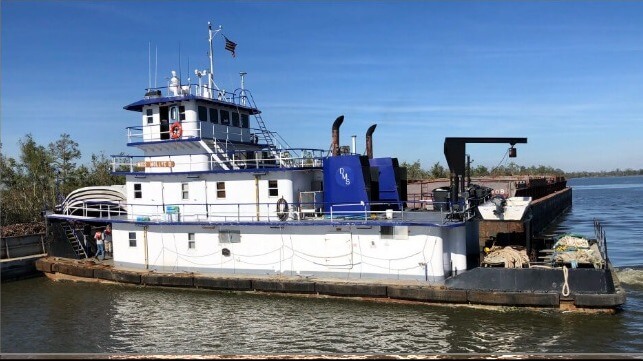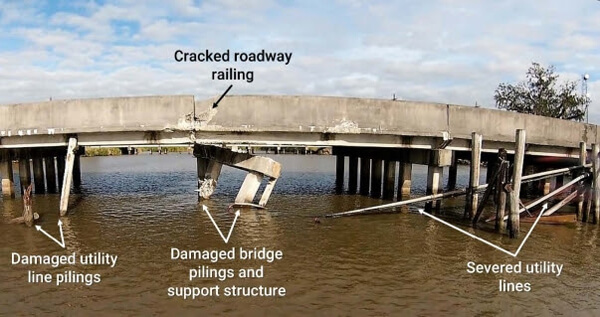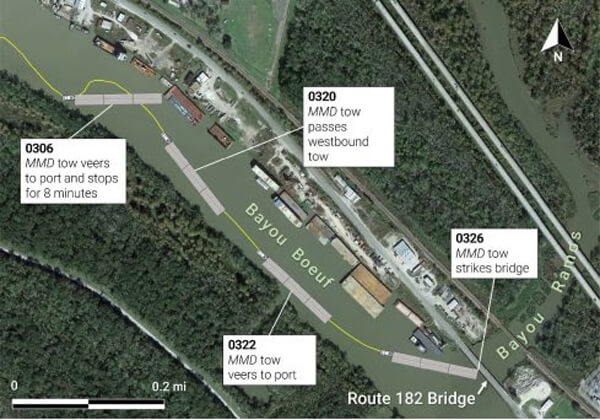Pilot Never Reported Hitting Louisiana Bridge During River Tow

The National Transportation Safety Board released its report on a December 2021 accident in which a road bridge running alongside the Intercostal Waterway just south of Morgan City, Louisiana, sustained an estimated $2 million in damages. What makes the case notable is that the damage was first discovered by utility workers responding to alarms. They reported it to the U.S. Coast Guard triggering an investigation that determined a barge-towing vessel had struck the bridge several hours earlier. The towing vessel with a crew of five aboard had proceeded away from the accident without notifying supervisors or the U.S. Coast Guard.
Utilities operating in the area reported receiving alarms from the water, electric, and gas lines on the bridge and sent workers out to the area to investigate the cause of the alarms. Arriving at the bridge, their crews determined that the utility lines on the south side of the bridge supported on timber pilings and cross bracing had been severed. A survey of the bridge revealed the Route 182 bridge sustained damage to several pilings, both above and below the waterline, as well as the concrete pile cap, girder, deck, bearing, and bridge railing above the piling.
The bridge was immediately closed and remained closed while repairs could be made. It was partially reopened after three weeks. Repairs to the bridge were estimated at $2 million.
“Traffic over the bridge was not stopped until the utility workers found the damage, hours after the casualty occurred,” the NTSB writes. “The bridge could have failed or severed gas and electric lines could have ignited a fire in the time between the striking and the finding the damage.”

Damage to the bridge (NTSB photo)
Alerted to the incident, the USCG began reviewing vessel traffic on the river. Reports indicate that the channel was over 500 feet wide. They also determined that there were no factors that made the waterway challenging to navigate, including little current in the area, and at the time of the incident the winds were light.
The contact with the bridge happened around 0330 local time with the NTSB noting that the bridge is not illuminated. However, it runs parallel to the river crossing over a shallow, non-navigable bayou. Later investigation also showed that a car had crossed the bridge with headlights and taillights visible moments before the impact.
The Coast Guard quickly identified the Miss Mollye D, an 86-foot towing vessel pushing six barges along the river as the vessel that had likely hit the bridge. Approximately six hours after the impact they contacted the towboat. The relief captain who had taken over command of the vessel at 0600 directed the lead deckhand aboard to inspect the barges. During that inspection, he found several broken rigging wires as well as pieces of concrete on one of the barges at the front end of the tow. Later investigation would identify that the concrete had come from the bridge.
The NTSB determined that the vessel’s pilot had taken the watch at midnight steering the tow along the river. He had been working off and on since 2010 for the operator Deloach Marine Services, but this was only the second time he had transited the waterway.

Track of the Miss Mollye D constructed by NTSB investigators (NTSB)
When he was interviewed, the pilot said he had not seen the bridge and denied making contact although admitted that the tow had left the channel. He was traveling at about 3.1 knots having just come around a gradual bend in the waterway. He said he was looking at the ECS display checking the weather information when he realized the tow was “not in a good position.”
He said he had reversed the engines spending about 15 minutes straightening the tow. No other crewmembers, including the deckhand on watch in the engine room, stated that they heard or felt the bridge contact, although the deckhand in the engine room recalled the engines cycling during his watch. A review of the vessel's data and AIS signal showed that it had also veered out of the channel a second time a few minutes earlier in the river. They had come close to striking vessels tied up along the river's edge but resumed the trip and passed another vessel before reaching the area at the bridge.
Toxicology tests were performed on samples that were collected at 1635 and they were negative. The pilot insisted he was getting 8 to 9 hours of sleep and not using cell phones or other distractions. Later toxicology however performed on hair samples taken in February 2022 tested positive for methamphetamine and its metabolite amphetamine, buprenorphine and its metabolite norbuprenorphine, and fentanyl. The NTSB notes that the methamphetamine could have been used to increase alertness and relieve fatigue.
The conclusion was that the pilot of the Miss Mollye D lost control likely due to impairment by factors such as fatigue or drug use.
